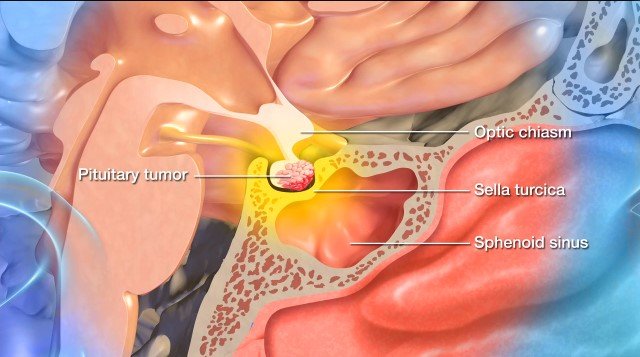Dr. Patil's Diabetes, Thyroid & Hormone Clinic | Dr. Himanshu Patil
Pituitary tumors and neuroendocrine disorders

The pituitary gland is a small, pea-sized gland located at the base of the brain. It is often called the “master gland” because it produces hormones that regulate various bodily functions, such as growth, metabolism, and reproduction. Pituitary tumors are abnormal growths that form in this gland. Most of these tumors are benign (non-cancerous), but they can still cause significant health issues by affecting hormone production or pressing on surrounding structures, such as the optic nerves.
Neuroendocrine disorders refer to conditions that affect the interaction between the nervous system and the endocrine system (the system that regulates hormones). These disorders can occur when there are abnormalities in the production, release, or regulation of hormones, often due to dysfunction in the neuroendocrine cells (cells that release hormones in response to neural signals).
Types of Pituitary Tumors
Functional Tumors: These tumors secrete hormones in excess, leading to hormonal imbalances.
- Prolactinomas: Tumors that produce excess prolactin, leading to symptoms like irregular menstruation, infertility, and milk production in women, and sexual dysfunction in men.
- Growth Hormone-Secreting Tumors: Excess growth hormone can lead to acromegaly (in adults) or gigantism (in children), resulting in abnormal growth of bones and tissues.
- Corticotropin-Secreting Tumors: These tumors produce excess ACTH (adrenocorticotropic hormone), which can lead to Cushing’s disease, characterized by weight gain, high blood pressure, and other symptoms.
Non-Functional Tumors: These tumors do not produce hormones but can cause problems by pressing on surrounding tissues, such as the optic nerves, leading to vision problems or headaches.
Symptoms of Pituitary Tumors
- Hormonal Imbalances: Symptoms depend on the type of hormone produced by the tumor, such as irregular periods, infertility, excess hair growth, or abnormal growth.
- Vision Problems: Tumors pressing on the optic nerves can cause blurred or double vision and loss of peripheral vision.
- Headaches: Constant or severe headaches are common due to pressure on surrounding brain structures.
- Fatigue and Weakness: Due to hormonal imbalances, some individuals may feel excessively tired or weak.
- Changes in Appearance: Depending on the tumor type, changes in skin, facial appearance, or body proportions (such as acromegaly) may occur.
Diagnosis and Treatment
- Imaging Tests: MRI or CT scans are used to detect the size and location of the tumor.
- Hormone Tests: Blood tests are conducted to measure hormone levels to identify any imbalances caused by the tumor.
- Surgery: The most common treatment is the surgical removal of the tumor, often performed through the nose (transsphenoidal surgery).
- Radiation Therapy: Used for tumors that can’t be fully removed or to treat tumors that have recurred.
- Medications: Certain tumors, like prolactinomas, can be treated with medications like dopamine agonists (e.g., cabergoline) to reduce hormone production and shrink the tumor.
Common Types of Neuroendocrine Disorders
Neuroendocrine Tumors (NETs):
- These tumors originate from neuroendocrine cells, which are found throughout the body, particularly in organs such as the lungs, pancreas, and gastrointestinal system.
- Carcinoid Tumors: These are the most common type of NET and usually occur in the lungs, stomach, or intestines. They often grow slowly and may not cause symptoms until they spread.
- Pancreatic Neuroendocrine Tumors: Tumors in the pancreas that can cause hormone imbalances, such as insulinomas (excess insulin) or gastrinomas (excess gastrin).
Cushing’s Syndrome:
- Cushing’s syndrome occurs when there is an overproduction of cortisol, often due to a tumor in the pituitary gland (Cushing’s disease) or adrenal glands.
- Symptoms include obesity, high blood pressure, diabetes, and skin thinning.
Pheochromocytoma:
- A rare tumor that originates in the adrenal glands and causes excess production of catecholamines (like adrenaline), leading to high blood pressure, sweating, headaches, and rapid heartbeat.
Hypothalamic-Pituitary Disorders:
- These involve dysfunctions of the hypothalamus or pituitary gland, which control many of the body’s hormone systems. Conditions can include hypopituitarism (reduced pituitary hormone production) or hyperpituitarism (excessive hormone production).
- Disorders like diabetes insipidus (excessive thirst and urination due to a lack of antidiuretic hormone) or acromegaly (caused by excess growth hormone) are examples of these disorders.
Thyroid Disorders:
- Disorders like Graves’ disease (hyperthyroidism) or Hashimoto’s thyroiditis (hypothyroidism) involve dysfunction of the thyroid gland, which is controlled by signals from the brain’s hypothalamus and pituitary.
Symptoms of Neuroendocrine Disorders
- Hormonal Imbalances: Symptoms like weight gain or loss, fatigue, mood swings, and irregular periods.
- Elevated Heart Rate and Blood Pressure: In disorders like pheochromocytoma or Cushing’s syndrome.
- Digestive Issues: Abnormal growth of neuroendocrine tumors in the gastrointestinal tract may cause nausea, pain, and weight loss.
- Flushing and Sweating: Symptoms often occur with carcinoid tumors or pheochromocytomas.
Diagnosis and Treatment
- Imaging Tests: MRI, CT scans, and specialized imaging like somatostatin receptor scintigraphy (used to locate neuroendocrine tumors).
- Blood and Urine Tests: To measure levels of hormones like cortisol, insulin, and catecholamines.
- Surgical Treatment: The most common treatment for neuroendocrine tumors is surgery to remove the tumor, if it is operable.
- Radiation Therapy: May be used if surgery isn’t an option or if the tumor has spread.
- Medications: Medications such as somatostatin analogs can control the release of hormones in tumors, while chemotherapy may be used for aggressive or metastatic tumors.
